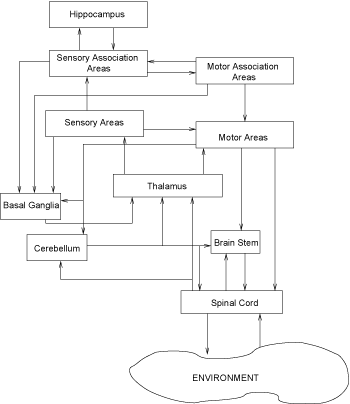Mechanisms for Cognition Development Inspired by the Mammalian Paradigm
by Michalis Maniadakis and Panos Trahanias
In recent years, mechanisms supporting the emergence of intelligence have attracted a lot of attention from researchers. Since the hard-wired, human-designed approach offers limited capabilities in the development of intelligent artificial organisms, modern approaches investigate mechanisms that allow cognition to develop based on the organism's interaction with the environment. In the Computational Vision and Robotics Laboratory (CVRL) of ICS-FORTH, an ongoing research effort studies the mammalian paradigm to develop mechanisms for cognition development in artificial organisms.
During the last few decades, many research efforts have focused on the development of intelligent machines. In the field of robotics, this is usually done by employing detailed algorithms to determine the behaviour of robots in certain environments. These purely computational approaches have facilitated the solution of well-defined problems. However, achieving ubiquity requires that robots be able to dynamically adapt to new circumstances, since real environments can be highly unpredictable. In recognising this fact, it is clear that contemporary, detailed computational approaches offer limited capabilities in approaching real-world problems.
New ideas for approaching the problems related to the development of machines that operate in the real world can be gained through observation of the everyday actions of biological organisms. Substantial research efforts have therefore been devoted to building 'artificial models' of biological organisms.
Since mammals exhibit the highest level of intelligence among biological organisms, they could be used as an excellent prototype for the development of machines with high cognitive abilities. Modern theories for the explanation of mammalian cognition argue that the observed behaviour of animals is a result of their free interaction with the environment. During environment exploration, subjectively important features are stored in the appropriate structures of the Central Nervous System (CNS). Evidently, this hypothesis could also form a basis for the development of cognition in artificial organisms.
In the Computational Vision and Robotics Laboratory (CVRL) of ICS-FORTH, the functional and anatomical properties of mammalian CNS structures are being investigated in parallel with the development of corresponding computational models. Functional success of the models is gauged by employing a robotic platform to support interaction with the environment. Cooperation between primitive computational modules follows the mammalian paradigm, constituting a global computational model of the mammalian CNS. The model illustrated in the Figure shows the basic CNS structures necessary to process sensory and motor information for a mobile robot.
 |
| A model of the Mammalian Central Nervous System. |
A general but flexible neural network structure has been designed to represent each structure of the CNS. All primitive computational structures have different internal dynamics (eg learning rules), appropriately defined to support the emergence of the desired functionality in the module. The synaptic weights in each neural network are obtained based on interaction with the environment (subjective experience) and internal dynamics. Consequently, the performance of the computational model is not predefined in detail by a human observer to mimic biological activation, but is an emergent result of the robot's experiences and the dynamics which guide the performance of its structural components.
The selection of internal dynamics in each module is performed following an evolutionary approach. A genetic algorithm is employed for each computational module to estimate the internal dynamic parameters. These allow the emergence of a similar functionality to that of the associated area of the mammalian CNS, after a certain number of robot-environment interactions. This approach has already been demonstrated through the implementation of various modules of the CNS model that facilitate robotic localisation and motion control within the workspace.
The global CNS model is obtained following a developmental approach, starting from the performance of simple tasks to gradually accomplishing more complex ones. The cooperation within computational CNS modules is achieved by employing a new evolutionary scheme to select the dynamics of the intermediate connective synapses within primitive modules. This is the current working direction, where primitive behaviours cooperatively form more complex ones.
The development of a robotic CNS (R-CNS) may shed light on the intricacies of real-world problems. Since the R-CNS is intended to support the emergence of adaptive robot behaviours which will be self-organised by subjective experiences, this approach might offer guidelines for the development of intelligence in artificial organisms in general. From a neurobiological perspective, the R-CNS computational model may offer the possibility of integrating human understanding of the mammalian CNS (M-CNS), while new ideas concerning the functionality of M-CNS could be further tested and evaluated.
Link:
http://www.ics.forth.gr/cvrl/
Please contact:
Panos Trahanias, ICS-FORTH
E-mail: trahania@ics.forth.gr
|



